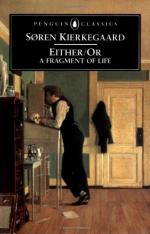
|
| Name: _________________________ | Period: ___________________ |
This test consists of 15 multiple choice questions and 5 short answer questions.
Multiple Choice Questions
1. What is David unable to appreciate about the parable?
(a) David is unable to appreciate the hidden language of heaven in the parable.
(b) David is unable to appreciate how the parable applies to his own life.
(c) David is unable to appreciate Nathan's literary skill.
(d) David is unable to appreciate the time Nathan takes to convey the parable.
2. What is the reader to understand about the content of Kierkegaard's letter?
(a) The reader is to understand that the contents of the letter apply to Kierkegaard's wife.
(b) The reader is to understand that the contents of the letter apply to King David.
(c) The reader is to understand that the contents of the letter apply to the reader himself and not to another.
(d) The reader is to understand that the contents of the letter apply to the prophet Nathan.
3. What is the only thing for which the author prays to God with his whole heart?
(a) That God will give him the patience to put up with his wife's nagging.
(b) That God will give him the judgement to know when his wife is lying.
(c) That God will give him the strength never to want to love another woman.
(d) That God will give him the strength to move on after his wife stops loving him.
4. What does the author say is the most intensive enjoyment?
(a) Drug taking.
(b) Clutching the enjoyment in the consciousness that it may vanish in the next moment.
(c) Dreaming as if you would live forever.
(d) Sexual intercourse.
5. What is the opening phrase of the work?
(a) "Red Fox to Chrome Eagle:".
(b) "Ladies and Gentlemen,".
(c) "Dear Friend,".
(d) "Hey, guy,".
6. What does the author say can crush the aesthetic in a human being?
(a) A Man.
(b) An act of cruelty.
(c) A Woman.
(d) Nothing can crush the aesthetic in a human being.
7. According to the author, what is the lifeblood of marriage?
(a) Uprightness.
(b) Frankness.
(c) Openness on a large scale.
(d) All of these.
8. What does the author say would be a matter of indifference to Christians?
(a) Whether Christ was literally an incarnation of almighty God.
(b) Whether Christ was ugly or handsome.
(c) Whether Christ physically rose from the dead.
(d) Whether Christ was born in December or July.
9. The author asserts that just as nothing is impossible for God, nothing is impossible for whom?
(a) The religious individual.
(b) The pure individual.
(c) The powerful individual.
(d) The humble individual.
10. Why does the author suggest the young man may be "depressed" and fear marriage?
(a) The young man may be thinking, "She doesn't really love me; all love is false."
(b) The young man's parents were unhappy in their marriage and abused him all his life.
(c) Perhaps the young man has not been taking his medication.
(d) The young man may be thinking, "Everything may change; what if this person that now I almost worship may change; what if, what if, etc."
11. What is the only way the author claims he would ever wish to be in relation to his wife?
(a) Submissive.
(b) Polygamous.
(c) Dominant.
(d) Monogamous.
12. The author claims what kind of feelings toward his wife?
(a) Feelings of devotion.
(b) Feelings of anxiety.
(c) Feelings of anger.
(d) Feelings of sadness.
13. What moment does the newly married couple attempt to postpone?
(a) The moment of consummation.
(b) The moment the couple realizes they are bored.
(c) The moment of tenderness.
(d) The moment of risk.
14. What are the excesses of the mystics according to the author of the letter?
(a) Praying all day and all night.
(b) Attempting to help every person they come across.
(c) Drinking and drug taking.
(d) Self-tormenting and annihilation of the physical.
15. What does the author say romantic love is built on?
(a) An ocean.
(b) An illusion.
(c) A rock.
(d) An undeniable reality.
Short Answer Questions
1. What idea does the insane man, of whom the author writes, have fixed in his head?
2. How does marital love manifest itself as historical?
3. What does the author claim Martin Luther said a Christian has never died of?
4. What character in opera does the author say embodies the state preceding love?
5. From whom does King David hear a parable?
|
This section contains 764 words (approx. 3 pages at 300 words per page) |

|




